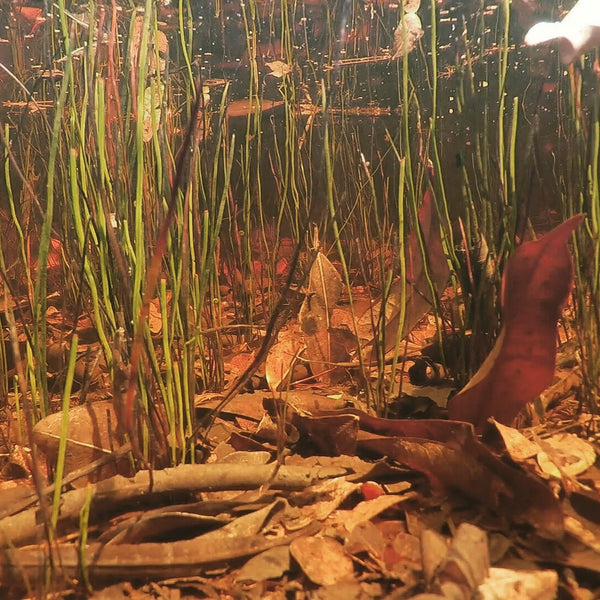- Continue Shopping
- Your Cart is Empty
The art of habitat representation: A case study...
As an observer of modern aquascaping- in a variety of forms, I've spent quite a bit of time looking at flooded forest floors. This interesting habitat offers incredibly interesting aesthetics and function. It's a habitat which gives us the opportunity to not only be creative, but to learn about its unique dynamics and function.
If we look at this habitat a little deeper, we can perhaps pull out some components of it, and consider what materials we could use to replicate its unique features. This is something that I love...assessing which materials would do the job. We have received so many requests about "...which ones do I use?" that it made a lot of sense for us to address this in terms of what we offer. Now, I realize that part of the fun is assessing and scheming and curating for yourself; however, we can't help but push a few ideas into your head to perhaps speed along your process!
Now, we've talked about flooded forest floors many times, but not in this specific context.

What would be some "cornerstone" materials that you'd use to represent this habitat? Well, let's break it down:
First, a forest floor has soil. It's sort of a "dirty" place (pun kind of intended...).
In our case, we could use a combination of standard aquarium substrates, like sand, perhaps combined with terrestrial soils, or planted aquarium soils. In one of my recent aquariums, I utilized a fine aquarium sand, coupled with some ground-up, clay-based aquatic plant soil (Ultum Nature Systems "Control Soil). I selected this material because the aesthetic and grain size, when combined, creates something that looks very much like the soils you'd find on a tropical forest floor.

And of course, no flooded forest floor would be complete without roots, branches, and stems. My recommendations from our "portfolio" would be one of more of the following: Oak Twigs, Senggani Root, or even "Spider Wood." Each brings its own aesthetic and function to the aquarium representation of this habitat.

You could keep the "roots and twigs" to a minimum, placed in a "flat" configuration on the substrate, or let some of them creep up into the "vertical", consuming a bit of the negative space in the aquarium. If you're using materials like the Senggani Root", there is the option of orienting them in a variety of ways. You could even cut up and utilize "bits and pieces" of these materials in lots of different ways, in order to represent that element of the habitat.

The other, and perhaps, most obvious component of this habitat is leaves. Whenever you have trees overhead, you're pretty much guaranteed to have lea yes failing to, and accumulating on the forest floor. And of course, when the waters arrive, the leaves become a dominant part of the newly aquatic habitat.

As you know, we're really into leaves, and we have a pretty good variety of different leaves available. It's really about what you like, the aesthetic you're looking to achieve, and the "scale" of the aquarium.

And of course, seed pods are perfect to use in this type of representation. Some of my personal faves would be smaller items, like Mokha Pods, Calotropis Pods, Dregea Pods, and Jacaranda Pods. Obviously, the choices are endless. I like these particular materials because they have varying degrees of durability, offer a diversity of shapes, and are of a "scale" that can work even in a smaller aquarium.

And of course, there are other possibilities to replicate this habitat. You can utilize larger materials which represent tree trunks and other large, buttressing structures which end up on the first floor. Larger pieces of driftwood, such as our "Malaysian Driftwood" and "Asian Driftwood," can represent these materials in a most effective way. If you can source very thick, substantial pieces to represent a tree trunk, either in the "upright" or "fallen" condition.

And then, there are those other materials- such as bark pieces; specifically, Red Mangrove Bark, which comes in larger, more "workable" sizes. Bark not only adds compounds like humic substances and tannins to the water, it creates a rather durable substrate upon which various microorganisms and fungi can anchor and proliferate- adding to the "functional" aspects of the aquarium habitat.

One additional component that you will find on a flooded forest floor would be terrestrial grasses. Many of the grasses in these forests are durable enough to survive these periods of inundation.
Now, we may not have access to the exact species of grasses that are found in these habitats (although you can do some research in academic papers online and find them); however, we can find some species which are representative of them. We could even utilize riparian plants- or perhaps even some aquatic plants (gulp), like Sagittaria, which can really work. Again, it's about representing- as opposed to strictly replicating- components of this habitat.

At the end of the day, about the best we can do is present to you some aspects of the habitat, and recommend some of the materials that you can use to recreate it- or aspects of it- in your home aquarium. And of course, there are numerous other materials you can use from our selections, or materials that you can collect yourself. The art and science of natural aquarium keeping is an evolving and enjoyable one!
And with that...
Stay interested. Stay creative. Stay observant. Stay diligent...
And Stay Wet.
Scott Fellman
Tannin Aquatics







Scott Fellman
Author